A
Auto Express
Guest
The latest Hyundai i30 does just enough to keep pace with a pool of very talented family hatchback rivals that includes the Ford Focus, Vauxhall Astra and Volkswagen Golf. It’s not the most exciting compact family car on the market, but it’s well built, refined and economical, and comes with a strong haul of standard equipment.
The entry-level 1.0 T-GDi petrol engine is our favourite, offering a truly grown-up driving experience despite its seemingly modest power output. A Renault Megane is more stylish and a SEAT Leon more fun to drive, but the i30 should find its way onto your shortlist if you’re in the market for a rational alternative to the Vauxhall Astra.
The Hyundai i30 is just one compact family hatchback in a class that has a number of very talented rivals. In isolation, the i30 has its merits, but when compared to cars like the Vauxhall Astra and Volkswagen Golf, it's a bit of an uninspiring choice. The i30 is available as a five-door hatchback and compact i30 Tourer estate, along with the five-door coupe-style i30 Fastback. There's a faster i30N version of the hatchback and Fastback.
• Best hatchbacks on sale right now
At the start of the range, the S model has steel wheels with plastic trims, but as standard all cars get a Bluetooth phone connection and air-con. Moving up to SE adds a five-inch touchscreen on the centre console, rear parking sensors, electric folding door mirrors and flashes of chrome trim. As the name suggests, SE Nav gets sat-nav on a bigger eight-inch screen, while Android Auto and Apple CarPlay provide additional connectivity options for smartphone users. Top-spec Premium and Premium SE versions get toys such as puddle lights, an electric driver’s seat and 17-inch alloy wheels.
Engines comprise two petrol units and a diesel – the latter available in two states of tune. The range starts with the 1.0 T-GDi 120PS turbo petrol three-cylinder (GDi stands for Gasoline Direct Injection). At the moment it's only available in S, SE and SE Nav specs, although it might come in higher specs if bosses see a demand for it. Above that sits the 1.4 T-GDi 140PS petrol, which comes in all trims bar S, including the sportier N-Line trim. The 1.6 CRDi diesel (108bhp or 134bhp) spans most of the range, but not S or N-Line.
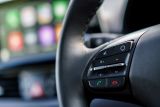
New Hyundai i30 - steering wheel detail
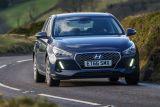
New Hyundai i30 - front action
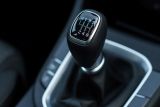
New Hyundai i30 - gear stick
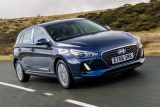
New Hyundai i30 - front
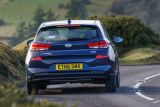
New Hyundai i30 - rear action

New Hyundai i30 - full front
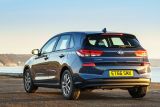
New Hyundai i30 - rear static
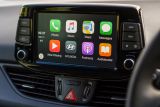
New Hyundai i30 - Apple CarPlay
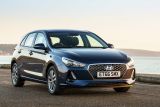
New Hyundai i30 - front static
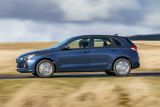
New Hyundai i30 - side
All models are fitted with a six-speed manual gearbox as standard, while the 1.4 T-GDi and 1.6 CRDi can be had with a seven-speed twin-clutch DCT auto. The upgrade is priced at £1,000, and only has a slightly negative effect on emissions and economy.
The i30 N is the range flagship and the first in a line of performance cars to be launched under the ‘N’ sub-brand. The standard i30 N with 247bhp is no longer available. Instead, the previously optional Performance version, with an electronic differential, bigger brakes and 271bhp, is now the sole i30 N model, priced at just over £30,000.
The i30 Fastback coupe is less impressive to drive, but arguably just as good to look at. It majors on style, specification, quality, value and packaging, and prices start from a little over £20,000.
• Best family cars on sale
As we've mentioned already, the i30 is in a fiercely competitive class with a variety of very strong rivals. Chief among these are mainstream choices such as the VW Golf, Vauxhall Astra, Renault Megane and Peugeot 308. These all have a premium feel about them that the i30 struggles to match. Elsewhere, the Skoda Octavia mixes quality and space, the Kia Cee'd is closely related to the i30, while the SEAT Leon, Mazda 3 and Ford Focus are sportier options, the Toyota Auris throws hybrid drive into the mix, the Alfa Romeo Giulietta is ageing but different, while the Fiat Tipo is a budget alternative and the Nissan Pulsar.
For an alternative review of the latest Hyundai i30 Hatchback visit our sister site carbuyer.co.uk
Continue reading...
The entry-level 1.0 T-GDi petrol engine is our favourite, offering a truly grown-up driving experience despite its seemingly modest power output. A Renault Megane is more stylish and a SEAT Leon more fun to drive, but the i30 should find its way onto your shortlist if you’re in the market for a rational alternative to the Vauxhall Astra.
The Hyundai i30 is just one compact family hatchback in a class that has a number of very talented rivals. In isolation, the i30 has its merits, but when compared to cars like the Vauxhall Astra and Volkswagen Golf, it's a bit of an uninspiring choice. The i30 is available as a five-door hatchback and compact i30 Tourer estate, along with the five-door coupe-style i30 Fastback. There's a faster i30N version of the hatchback and Fastback.
• Best hatchbacks on sale right now
At the start of the range, the S model has steel wheels with plastic trims, but as standard all cars get a Bluetooth phone connection and air-con. Moving up to SE adds a five-inch touchscreen on the centre console, rear parking sensors, electric folding door mirrors and flashes of chrome trim. As the name suggests, SE Nav gets sat-nav on a bigger eight-inch screen, while Android Auto and Apple CarPlay provide additional connectivity options for smartphone users. Top-spec Premium and Premium SE versions get toys such as puddle lights, an electric driver’s seat and 17-inch alloy wheels.
Engines comprise two petrol units and a diesel – the latter available in two states of tune. The range starts with the 1.0 T-GDi 120PS turbo petrol three-cylinder (GDi stands for Gasoline Direct Injection). At the moment it's only available in S, SE and SE Nav specs, although it might come in higher specs if bosses see a demand for it. Above that sits the 1.4 T-GDi 140PS petrol, which comes in all trims bar S, including the sportier N-Line trim. The 1.6 CRDi diesel (108bhp or 134bhp) spans most of the range, but not S or N-Line.

New Hyundai i30 - steering wheel detail

New Hyundai i30 - front action

New Hyundai i30 - gear stick

New Hyundai i30 - front

New Hyundai i30 - rear action

New Hyundai i30 - full front

New Hyundai i30 - rear static

New Hyundai i30 - Apple CarPlay

New Hyundai i30 - front static

New Hyundai i30 - side
All models are fitted with a six-speed manual gearbox as standard, while the 1.4 T-GDi and 1.6 CRDi can be had with a seven-speed twin-clutch DCT auto. The upgrade is priced at £1,000, and only has a slightly negative effect on emissions and economy.
The i30 N is the range flagship and the first in a line of performance cars to be launched under the ‘N’ sub-brand. The standard i30 N with 247bhp is no longer available. Instead, the previously optional Performance version, with an electronic differential, bigger brakes and 271bhp, is now the sole i30 N model, priced at just over £30,000.
The i30 Fastback coupe is less impressive to drive, but arguably just as good to look at. It majors on style, specification, quality, value and packaging, and prices start from a little over £20,000.
• Best family cars on sale
As we've mentioned already, the i30 is in a fiercely competitive class with a variety of very strong rivals. Chief among these are mainstream choices such as the VW Golf, Vauxhall Astra, Renault Megane and Peugeot 308. These all have a premium feel about them that the i30 struggles to match. Elsewhere, the Skoda Octavia mixes quality and space, the Kia Cee'd is closely related to the i30, while the SEAT Leon, Mazda 3 and Ford Focus are sportier options, the Toyota Auris throws hybrid drive into the mix, the Alfa Romeo Giulietta is ageing but different, while the Fiat Tipo is a budget alternative and the Nissan Pulsar.
For an alternative review of the latest Hyundai i30 Hatchback visit our sister site carbuyer.co.uk
Continue reading...
